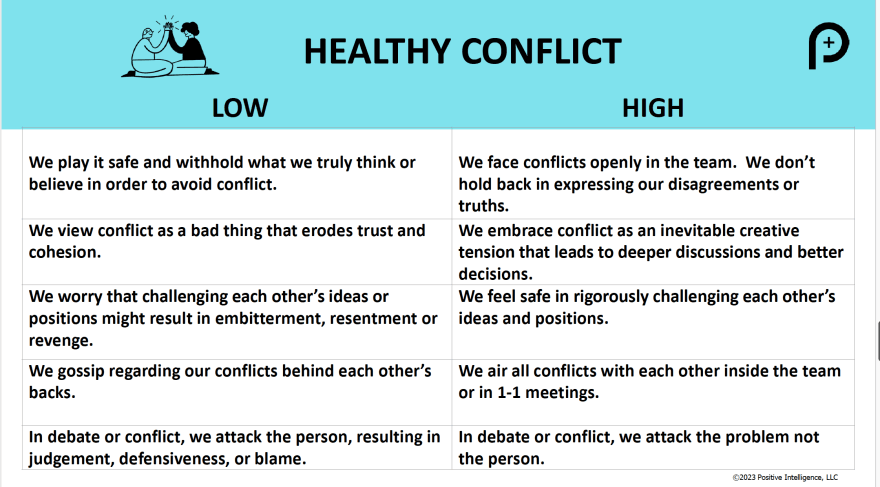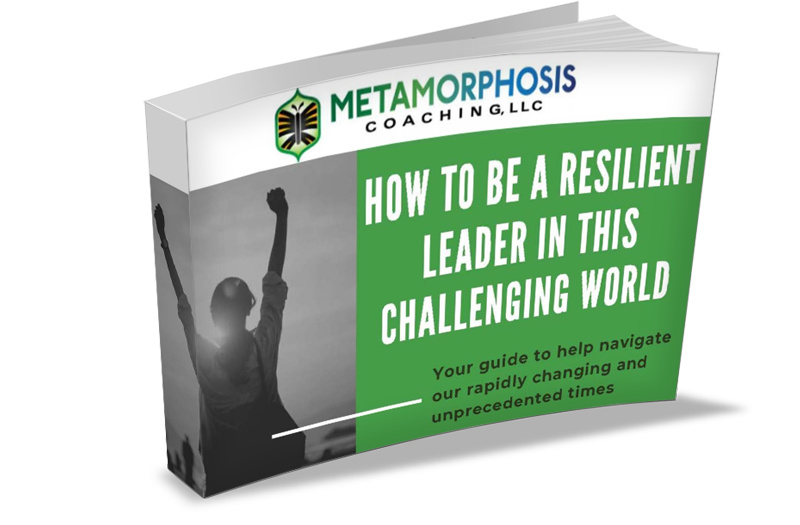Embracing Conflict for Results and a Healthy Bottom Line (Part 3 of 4)

Embracing Conflict for Results and a Healthy Bottom Line
Part 3 of a 4-Part Series
by Doni Landefeld, Ph.D.
Advanced Certified Personal and Executive Coach
Certified Positive Intelligence Coach
EQ-i 2.0 and EQ360 Certified
March 2023
It typically exists as two different extremes between people and in organizations – manifesting as either avoidance or overdramatization. On one end of the spectrum, we see some individuals who thrive on the drama of conflict and they live for the debate, argument or fight. In organizations whose leaders employ a pace-setting or coercive hierarchy, this does grave damage in establishing the psychological safety that is critical to creating a healthy culture. And it feeds into unnecessary drama. Or, it can spawn avoidance on the other end of the spectrum with less extreme variations occurring between the poles.
We’re talking about conflict and it’s no coincidence that organizational development masters including Patrick Lencioni and Shirzad Chamine consider it an essential ingredient to creating thriving relationships. We can apply all 10 of the saboteurs from the Positive Intelligence™ framework and how they keep us from embracing conflict as an opportunity – here are how they show up and how I propose some overlap with Walkers trauma typology model:
Fight – As the name implies, is the aggressive, more hostile response. Saboteurs that can rear up include the Judge, Controller, Stickler and sometimes Hyper-rational and Hyper-Achiever
Flight – The response to flee or bounce away from something or someone perceived as painful. Saboteurs may include Restless, sometimes Hyper-achiever and Avoider
Freeze – The inability to take action as the vagal nerve virtually cripples an effective response. Saboteurs may include Avoider, Hyper-vigilant, sometimes Victim
Fawn – Think of sucking up, being ingratiating or punting your own needs to either keep the peace or appeal to others at an extreme level. Saboteurs include Pleaser, sometimes Avoider and Victim
As I’ve immersed myself in Positive Intelligence since the onset of the Pandemic, I’m inspired by its application and streamlining of so many other social science platforms. Conflict theory, Change Management, and Emotional Intelligence are just a few.
And I’d like to invite you to embrace conflict as an opportunity. Avoiding challenges only results in a festering of problems and the absence of deepening relationships with others. The result is wasted time, strained relationships and a stress response. On the other end of the extreme – going all in ‘sturm and drang’ demotivates others, damages relationships, erodes trust and also negatively impacts performance, productivity and well-being.
Embracing conflict is both an art and a science. When it is in a healthy state, conflict deepens trust and transcends performance and relationships to drive incredible results.
“Does the human being reason? No; he thinks, muses, reflects, but does not reason… that is, in the two things which are the peculiar domain of the heart, not the mind, politics, and religion. He doesn’t want to know the other side. He wants arguments and statistics for his own side, and nothing more.” ~Mark Twain
The following chart is an example of what healthy and harmful conflict might look like in an organization.

The responsibility of leadership (and we are all leaders within our sphere of influence) is to look for underlying aspirations instead of positions and use discernment instead of judgment to create a culture of healthy conflict.
Let’s use the metaphor of growing a beautiful garden. In that garden, we have both roses and weeds. When weeds are preened and kept under control, the roses are better positioned to thrive and bloom in all their glory. Such is the case for embracing conflict and there are really two key ingredients to nurturing healthy conflict:
Be curious – to better understand someone else’s aspirations requires exploring and leaning into curiosity. A closed mind never grows and so an ability to explore others’ viewpoints presents leaders with an opportunity for growth while deepening relationships with others by searching for understanding instead of exerting position. Remember, the ultimate responsibility of all leaders is to inspire and this is not done by positional power! Influence happens via inspiration. Get curious. Ask questions. Consider the other person’s aspiration might be 5-10% valid. Deepen relationships, grow and get closer to a win-win.
Use empathy – one of the most powerful and yet underutilized and misunderstood powers is understanding and connecting with others. The goal here is to connect to an underlying emotion. Used in tandem with curiosity to ask questions. One of the leading indicators that you’re missing the mark connecting with someone is when they stay stuck in a story. If you are unable to move them beyond their story in some fashion, there is the opportunity to double down on empathy and fully hear (not just listen!) to the other party. For a workplace example, be sure to listen to the video above.
So far we’ve covered three of the four leadership pillars necessary for creating high-powered teams. Next month stay tuned as we unpack the final pillar and close the gap in how organizations may unleash the power of their teams to drive results and revenue.
- Triple Purpose (we covered in February’s newsletter)
- Earned Trust(covered last month)
- Healthy Conflict
- Mutual Accountability (coming up in May)
Did you know that there’s a program for your team or organization to learn and master the Four Pillars of High-Powered Teams and Leadership? It begins with a 7-week foundational Positive Intelligence program and segues into a transformational experience for Leadership Teams and Executives.
If you’d like to learn how to re-energize your team and ignite inspiration, let’s explore your challenges. Schedule your complimentary right-fit session here:
Special Report:
How to be a Resilient Leader in this Challenging World. PLUS More Free Resources!

Sign up below and get your FREE "How to Be a Resilient Leader in This Challenging World" Report today!

